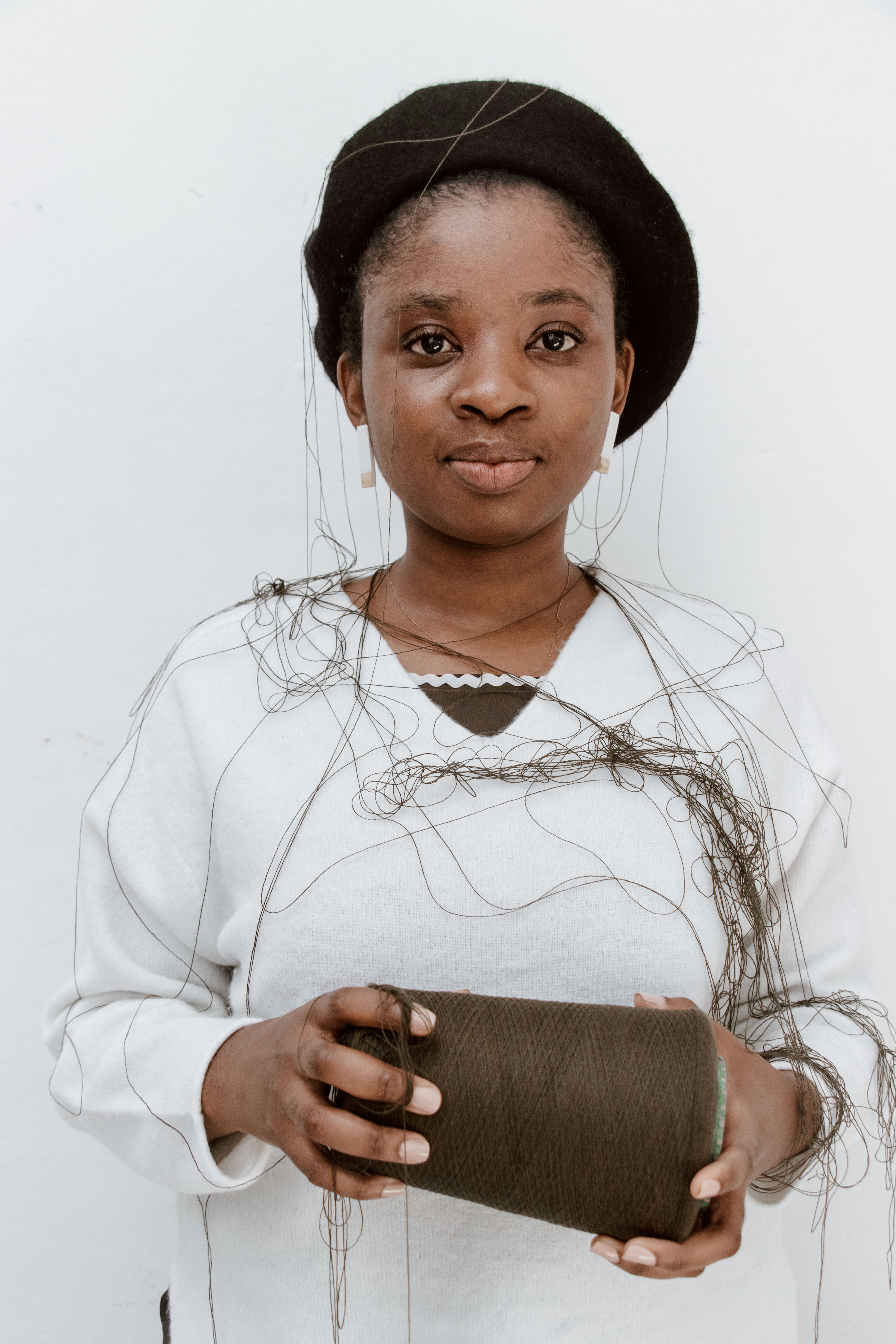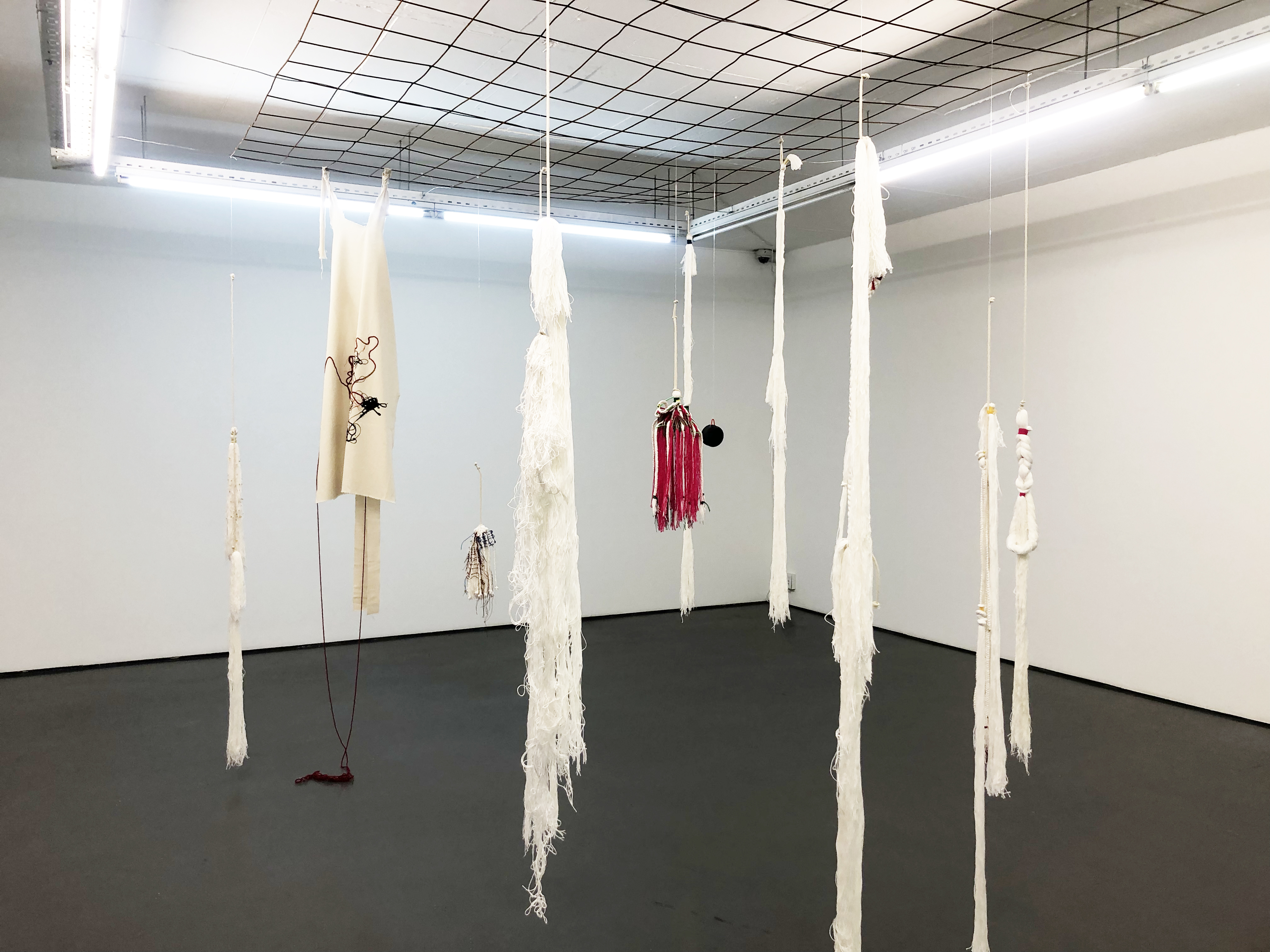FEATURE ︎︎︎
Threaded histories and spiritual tactility:
Text by Christa Dee
︎ ︎︎︎ ︎
Threaded histories and spiritual tactility:
The fibre art of Ditiro Mashigo
Text by Christa Dee
︎ ︎︎︎ ︎
Ditiro Mashigo views her practice as a hybrid between fashion and art, with the skills from each half creating a wonderfully vibrant middle ground. The exhibition resulting from the project Art After Baby, sees these two worlds meet for the first time in an exhibition format. This marks a significant moment in Mashigo’s career and evolution in her modes of making. Showcasing new fibre art and monotypes, this presentation articulates an accumulation of thematic references – a powerful female familial lineage, embracing domestic spaces, her ongoing spiritual journey and her Pedi culture.

The exhibition includes mixed media work such as Perseverance o tswala Katlego (2023) offering an earth-bound colour palette. This tapestry presents shades of green, deep reds and yellows knotted and woven together with thin plastic tubing of the same tones. In this way, viewers can experience an exploration of materiality and weaving techniques, producing a beautifully unkempt textured piece that invites the impulse to run one’s fingers over it. Here, textile-making can be read as a metaphor for the flexibility of the human spirit, the strength of women-led domestic practices and a visual representation of how memories are passed on through generations – core inquiries in Mashigo’s work.
Prints such as Lekunutung le Morena (2023), speak to the fragility of life and the permanence of mark-making. The addition of embroidery to her prints – thinking about the action of piercing the surface and moving thread through this opening – brings viewers’ attention to Mashigo’s reflections on the spiritual realm. Her works are often made while listening to praise music, channelling this sonic influence and her own long-term personal divine journey. The prints are also the result of her realisation over time that some of what she wants to create can also exist on flat surfaces like paper.
Prints such as Lekunutung le Morena (2023), speak to the fragility of life and the permanence of mark-making. The addition of embroidery to her prints – thinking about the action of piercing the surface and moving thread through this opening – brings viewers’ attention to Mashigo’s reflections on the spiritual realm. Her works are often made while listening to praise music, channelling this sonic influence and her own long-term personal divine journey. The prints are also the result of her realisation over time that some of what she wants to create can also exist on flat surfaces like paper.
While formally educated in textile design at the Tshwane University of Technology, Mashigo has been surrounded by women who have engaged in craft and design throughout her life. Her great-grandmother – whom she only knows through stories – has had a monumental impact on her approach to thinking about garments and softening her space of creativity. “She fashioned the home in her own likeness. The interiors she did herself. She created surfaces and things that resembled who she was,” Mashigo shares. This has influenced her emphasis on creating work inspired by surface patterns born out of a contemporary South African aesthetic. It has also allowed her to focus on what brings joy, even though some of what she makes is rooted in heavily-charged, emotional experiences.
Taking this further, Mashigo expresses, “When I create these textile objects, I think of that space of nurturing and family and my maternal lineage. And the kind of umbilical cord that runs from me to my mother, to my grandmother, to my great-grandmother, to my great-great-grandmother. Information is downloaded through the cord and feeds me. I hope to be able to pass it down to my children. That's how I think about my visual language. It is very much anchored in the tactile world as well as the memory world, the world of my history, who I am and who I am becoming.”
Taking this further, Mashigo expresses, “When I create these textile objects, I think of that space of nurturing and family and my maternal lineage. And the kind of umbilical cord that runs from me to my mother, to my grandmother, to my great-grandmother, to my great-great-grandmother. Information is downloaded through the cord and feeds me. I hope to be able to pass it down to my children. That's how I think about my visual language. It is very much anchored in the tactile world as well as the memory world, the world of my history, who I am and who I am becoming.”
When I create these textile objects, I think of that space of nurturing and family and my maternal lineage.
Turning the clock back to 2017, Mashigo’s final-year textile design project titled Maadingwa was when the designer-artist made it her mission to think about sustainability with that work being an upcycled collection. More importantly, it was the moment in which sound became a key agent in how her work manifests. She began thinking about how Sepedi (as with other languages) has borrowed and swapped words from other South African languages, forming new ways of expressing one's perspective on the world. Not only does this show her interest in how her mother tongue and culture continue to respond to the world, but it also nourishes her spiritual journey.
Sound is a form of communication to other people but also to the non-physical. Music, praise songs, and prayer are critical parts of Mashigo’s life. They create the conditions from which she is able to make, compelling her hands to dance with her materials. This lively, celebratory place of creative birth stimulates a tactility that is gestural and always in motion despite the fixedness of techniques such as screenprinting and embroidery.
Sound is a form of communication to other people but also to the non-physical. Music, praise songs, and prayer are critical parts of Mashigo’s life. They create the conditions from which she is able to make, compelling her hands to dance with her materials. This lively, celebratory place of creative birth stimulates a tactility that is gestural and always in motion despite the fixedness of techniques such as screenprinting and embroidery.

Music, praise songs, and prayer are critical parts of Mashigo’s life. They create the conditions from which she is able to make, compelling her hands to dance with her materials.

Mashigo’s brand Serati Ltd Label condenses these thoughts, enabling her to make designs for what she describes as “a majestic woman who resembles everything and anything that is African and beautiful.” This is also a vision of the woman she wants to embody through her life and her artistic outputs. “I look at women as sort of these angelic beings,” Mashigo continues, “Women pray, women feed and nurture, women create spaces of worship, women create environments that are enabling for growth and that is sacred work to me. Even when I have my eyes closed and I think of something to create, I always go right back to the sacred space that women occupy in our lives and in their own lives. I always want to celebrate that.”
Ditiro Mashigo is one of two artists selected to take part in a dual exhibition following the Art After Baby initiative by the Independent Network for Contemporary Culture & Art at the Keyes Art Mile. The exhibition will take place from 2-30 November 2023.